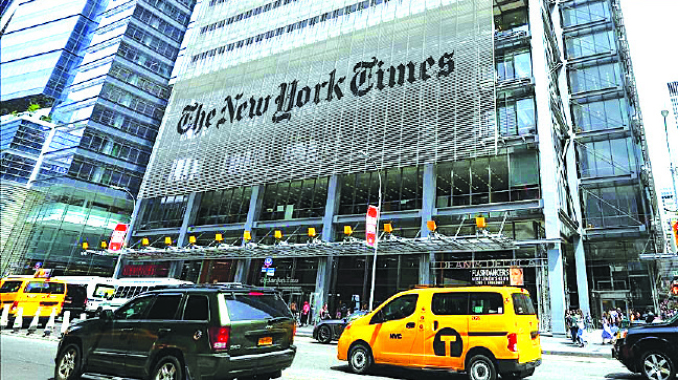How US publications demonise Africa

Milton Allimadi
Correspondent
When American journalists for publications such as the New York Times started writing about Africa in the 20th century they adopted the racist template of demonising Africa created by the European so-called explorers who went to Africa between the 17th and the 19th centuries.
These journalists “stories” even included fabricated incidents that never occurred to make them appear more “tribal” or “savage,” my new book, “Manufacturing Hate: How Africa Was Demonised In Western Media” reveals.
The whole objective of demonising Africa was to justify colonial conquest and later, in the post-colonial period, to rationalise continued domination of the continent.
The so-called “explorers” went to Africa and “discovered” and gave European names to Nam Lolwe, which became Lake Victoria, and Mosi-oa-tunya, which became Victoria Falls. Names of other lakes, rivers, mountains, and even countries, were changed to European ones all over Africa.
These so-called “explorers” were agents of imperialism. Some of them, like Samuel Baker and Frederick Lugard even became governors.
As “explorers” their mission was to map the African continent and identify the areas with rich resources. They paved the way for formal partition of Africa which came later during the last two decades of the 19th century. This “Scramble for Africa” culminated in the Berlin Conference of November 1884 to February 1885 for the partition.
As King Leopold II of Belgium declared, he wasn’t to be denied his share of the “magnificent African cake.”
The continent was sliced up amongst the European powers with the principle diners being Britain, France, Belgium, Portugal, Spain, Germany, and Italy. King Leopold operated the Congo territory as his personal possession, amassing a colossal fortune while exterminating an estimated 10 million Congolese.
In order to justify the extermination of Africans and the plunder of the continent’s resources the so-called explorers promoted white supremacy and African innate backwardness in their so-called “journals” which became best-selling books in Europe and elsewhere. They were the principle agents of widely disseminating the racist image of Africa around the world.
The more dangerous encounters they claimed to have survived in Africa, the more books they were able to sell. Established writers encouraged novices to embellish their accounts with concoctions.
“It has just struck me that you could not do better than write a short description of your travels in Africa,” John Hanning Speke, author of “Journal of The Discovery of the Source of the Nile,” wrote in a letter to John Petherick, a contemporary traveller; the account, Speke advised, should be well “loaded with amusing anecdotes and fights with the natives: the thing would tell admirably just at present, and for the future would keep the world looking anxiously for your peregrination.”
The so-called “explorers” were rabid racists. In 1866, the egomaniacal traveller, Samuel Baker, who called himself “Baker of the Nile,” a reference to his purported contribution toward “finding” the source of the river Nile — the source was called Nam Lolwe by Africans; the Europeans renamed it Lake Victoria — published “Albert N’Yanza, Great Basin of the Nile.”
“I wish the black sympathisers in England could see Africa’s inmost heart as I do, much of their sympathy would subside,” Baker wrote in one passage: “Human nature viewed in its crude state as pictured amongst African savages is quite on a level with that of the brute, and not to be compared with the noble character of the dog. There is neither gratitude, pity, love, nor self-denial; no idea of duty; no religion; but covetousness, ingratitude, selfishness, and cruelty.”
Baker added, “When the horse and the ass shall be found to match in double harness, the white man and the African black will pull together under the same regime.”
The racist propaganda was made to pave the way for commerce. “England, the great chief of the commercial world, possesses a power that enforces a grave responsibility. She has the force to civilise. She is the natural coloniser of the world,” Baker wrote.
When American publications such as The New York Times started sending writers to Africa in the 20th century, they continued Samuel Baker’s narrative.
When the Times sent Homer Bigart, a reporter who had already won the Pulitzer Prize — America’s highest journalism award — two times, to cover decolonisation in Africa, he showed his contempt for the assignment.
“I’m afraid I cannot work up any enthusiasm for the emerging republics,” Bigart wrote, in an undated letter to Emanuel Freedman, his editor in New York. “The politicians are either crooks or mystics. Dr. Nkrumah is a Henry Wallace in burnt cork. I vastly prefer the primitive bush people. After all, cannibalism may be the logical antidote to this population explosion everyone talks about.”
Bigart’s favourite terms for describing the Africans he wrote about were “barbaric,” “macabre,” “grotesque,” and “savage.” The contempt for Africa that he wrote openly about to Freedman was also conveyed in what were published in the Times, purporting to be news articles.
One such Bigart article was published under the contemptuous headline “Barbarian Cult Feared in Nigeria” in The New York Times on January 31, 1960.
The article read: “A pocket of barbarism still exists in eastern Nigeria, despite some success by the regional government in extending a crust of civilisation over the tribe of the pagan Izi . . . A momentary lapse into cannibalism marked the closing days of 1959, when two men killed in a tribal clash were partly consumed by enemies in the Cross River country below Obubra.”
After claiming that there had been a “lapse into cannibalism” Bigart contradicted his own concoction, when in the same article he also wrote, “None of the victims was eaten, at least not by society members. Less lurid but equally effective ways were found to dispose of them.”
Freedman, the foreign news editor, encouraged the racist reporting. He wrote a letter to his reporter on March 4, 1960 claiming he was now the “leading expert on sorcery, witchcraft, cannibalism and all the other exotic phenomena indigenous to darkest Africa.”
When New York Times editors believed stories filed from Africa were not “tribal” enough, they took matters into their own hands, and fabricated incidents that had not occurred, my book shows. When the Times sent Lloyd Garrison to cover the war in Biafra, he was shocked by a fabrication about Nigerians wearing “leaves” that was inserted into one of his articles published on May 31, 1967, by editors in New York.
“The reference to ‘small pagan tribes dressed in leaves’ is slightly misleading and could, because of its startling quality, give the reader the impression that there are a lot of tribes running around half-naked,” Garrison wrote, rather diplomatically, in a letter to the foreign news editor dated June 5, 1967.
“If it is not enough to say Yorubas or Ibos, as one would the Welch or the Walloons, then use the word tribe,” Garrison continued. “But not tribesmen, please. The first is less offensive, the second invites the image of savages dancing around the fire.” But this was, of course, precisely the image that the Times’ foreign news desk wanted to create.
Here in the United States, in addition to promoting contempt and racism toward Africans and Black people, the demonisation created shame about Africa in the African American population. Malcolm X discussed this topic in a speech on February 14, 1965, one week before his assassination.
Malcolm said, the “colonial powers of Europe, having complete control over Africa, they projected the image of Africa negatively. They projected Africa always in a negative light: jungles, savages, cannibals, nothing civilised. Why then naturally it was so negative it was negative to you and me, and you and I began to hate it.
“We didn’t want anybody to tell us anything about Africa, much less calling us ‘Africans.’ In hating Africa and hating the Africans, we ended up hating ourselves, without even realising it. Because you can’t hate the roots of a tree and not hate the tree. You can’t hate your origin and not end up hating yourself. You can’t hate Africa and not hate yourself.”
Thirty years after Malcolm’s speech, a Washington Post reporter named Keith Richburg displayed the most perverted manifestation of Black self-hatred.
The Washington Post published a reactionary article, by Richburg under the headline, “A Black Man in Africa,” in the April 10-16, 1995, issue of the newspaper’s National Weekly Edition.
At the time Richburg was the Post’s Nairobi-based Africa correspondent. He had covered Rwanda’s inter-ethnic massacres of 1994. In his article Richburg described his feelings as he watched “discoloured, bloated bodies floating” down a river in Rwanda toward Tanzania.
He recalled his “revulsion,” the “sorrow,” and the “pity” he felt for the victims, many of whom had been hacked with machetes. Richburg wrote that as he witnessed the bodies, he realised how fortunate he had been.
After all, had his ancestors not been blessed by being captured and shipped as enslaved Africans 400 years earlier, “There but for the Grace of God go I.”
Slavery, Richburg declared, had rescued him by transplanting his ancestors to the Caribbean, away from Africa. Otherwise, he too “might have instead been one of” the victims of the Rwanda massacre or he might have “met some similarly anonymous fate in any one of the countless ongoing civil wars or tribal clashes on this brutal continent. And so I thank God my ancestor made that voyage.”
“A Black Man in Africa,” never would have been published had it not been written by an African American. The article was filled with many repugnant anti-Africa comments that were similar to the malevolent observations about the continent made by the European travellers between the 17th and 19th centuries and reporters such as The New York Times’ Homer Bigart in the 1960s.
The Washington Post’s editors presumably believed the newspaper would be immunised from any accusations that the publication was disseminating racist notions about Africa since the writer was Black. This is a well-used tactic: front a pliant Black man to insert a dagger into the backs of other Black people — to do what some European Americans would like to do if they could get away with it.
What was Richburg saying to the millions who perished, while packed like sardines in the putrid holes of the enslavers’ ships during the Middle Passage? What of the diabolical tortures described in C.L.R James’ 1938 classic, “The Black Jacobins”? James informed readers how depraved French enslavers in Haiti packed dynamite into the anus of rebellious enslaved Africans and then ignited the fuse.
This history of demonisation of Africa has left an indelible impression in the West of a continent inhabited by sub-humans. This in part explains why today in the 21st century Western governments have no qualms in supporting, financially and militarily, corrupt and even genocidal regimes on the continent — To them, what’s the big deal if a few million Africans are exterminated? As Baker put it in the 19th century, Africans are “not to be compared with the noble character of the dog.”
“Manufacturing Hate: How Africa Was Demonised in Western Media” addresses these issues and many more.
The book is available by ordering directly from the US publisher Kendall Hunt Publishing Co.
Milton Allimadi, is the publisher of the Black Star News. [email protected].









Comments